It is appropriate to look into the early history of parish development in Ottawa East, and to trace briefly the changes that have occurred in parish structure since the first church was established to serve Catholics in the area.
No doubt, parish roots go back far beyond the Ottawa that even the oldest parishioners can recall, into those early Bytown days when the young settlement consisted only of a few crude shanties on the banks of the recently completed Rideau Canal. It may be that, more than a century earlier, one of the Holy Canadian Martyrs, whose memory is commemorated in the name of the parish, paused briefly on his way to the Huron mission fields to perform the first celebration of the Holy Eucharist in this area. The first priest to serve in the new settlement of Bytown was assigned to duty here in 1827 from the already established community of Richmond. The first Catholic church was built in Bytown in 1832 on the site of the present Basilica. Construction of the present imposing edifice began some eight years later. Then, in 1846, the parish of St. Patrick’s was formed to serve the Catholics living on the west side of the canal, in what was known as Upper Town.
With the arrival of the Oblate Fathers in Ottawa in 1844, and the coming of Bishop Guigues as the first Bishop of the new diocese of Ottawa three years later, the Catholic community experienced a surge of activity that was to continue for many years.

One of the first actions of the Bishop was to request the Oblates of Mary Immaculate to take over the operation and direction of Bytown College, which was eventually to develop into the University of Ottawa. Then, in 1856, the Oblate Fathers were called upon to form a new bilingual parish in Lower Town, to be known as St. Joseph’s. The community of Ottawa East was then known as Archville and lay just beyond the limits of the newly formed city of Ottawa.
The first parish priest of St. Joseph’s was Father Alexandre Trudeau who conducted the first services in the new parish church in 1856. St. Joseph’s was to continue as a bilingual parish for more than 30 years until the French-speaking parish of Sacre Coeur was formed.
At the turn of the century, it was decided that the Catholics of Ottawa East should have a church of their own, and the new parish of Holy Family was formed, again a bilingual parish under the direction of the Oblate Fathers. On March 24, 1901, the first services in the new parish were held in an old wooden building, located on the Oblate property on Main Street, known at the time as the White House. Shortly afterwards, construction was started on the new Holy Family Church on a site on the south side of Oblate Avenue.
The first parish priest of Holy Family parish, Father Charles Charlebois, known affectionately as Father Charles, remained with the parish until 1913. He was successful in welding the English and French-speaking components of the parish into a happy and congenial parish family. Although the Anglican Church of the Ascension had been established in Ottawa East some twenty years earlier, the new Holy Family parish contributed greatly to the community at large and was accepted by all, regardless of religious beliefs.
One of the most prominent families in the new parish was that of Bernard Slattery, a successful merchant and a large landholder in the southern part of Ottawa East. Many of the present members of the parish live in homes located on land that was at one time part of the Slattery farm. Mr. Slattery was very active in the formation of the parish and his benevolence was demonstrated by his many gifts to the new church. The old Slattery home is still located within parish boundaries at the junction of Main Street and Riverdale Avenue.
In 1930, following the formation of the English Oblate Province, it was decided to divide the Catholic community of Ottawa East into two distinct parishes. The French-speaking parishioners were to remain in the old Holy Family Church and the English-speaking members were to form a new parish, using as a temporary place of worship the chapel of the new St. Patrick’s College. On January 10, 1930, approval was granted to establish the new parish; it was named Holy Canadian Martyrs after the Holy Canadian Martyrs who were canonized that same year on June 29, 1930.
From that time, English-speaking Catholics of Ottawa East had an identity of their own, and an era of steady development began. Father Killian, OMI, the new pastor, was welcomed by his parishioners and by the non-Catholics of the community and soon became a friend to all. Born in Pittsburgh, USA, he served for many years with the Oblates in Canada and had played an important role in the founding of St. Patrick’s College.
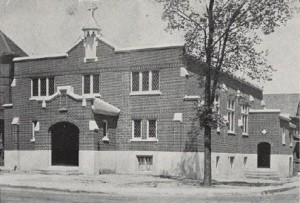
Property for the new Canadian Martyrs Church was obtained at the corner of Main Street and Lees Avenue, and construction was begun immediately.
The first services in the new church were held in the Spring of 1931.
The formative years of the new parish coincided with the great depression of the thirties when many of the families experienced difficult times.
However, the hard times seemed to draw the parish family closer together. Weekly card parties held in the basement of the church were well attended and the annual bazaars and teas were always successful. Two important organizations were active during this period, the Catholic Women’s League and the Holy Name Society. Both have played a vital role in the spiritual and social development of the parish.
Father Killian continued as parish priest until 1937 when he was replaced by Father William  Doran, OMI whose family had been for years members of St. Joseph’s Parish. During Father Doran’s seven years as pastor, the parish grew and prospered. New housing developments in the southern part of Ottawa East resulted in a large increase in the parish family. Due to ill health, Father Doran was forced to retire from the parish in 1944. From that time until mid 1945, Father Joseph Scannell OMI, a gifted speaker and highly respected priest, served the parish. Father Scannell was very popular among the religious and lay communities alike, resulting in his services being sought for the conducting of missions and retreats.
Doran, OMI whose family had been for years members of St. Joseph’s Parish. During Father Doran’s seven years as pastor, the parish grew and prospered. New housing developments in the southern part of Ottawa East resulted in a large increase in the parish family. Due to ill health, Father Doran was forced to retire from the parish in 1944. From that time until mid 1945, Father Joseph Scannell OMI, a gifted speaker and highly respected priest, served the parish. Father Scannell was very popular among the religious and lay communities alike, resulting in his services being sought for the conducting of missions and retreats.
Father Scannell’s assistant during this time was a young Irish priest, Father Cornelius Herlihy OMI who had come to Canada a few years earlier, and had been teaching novices at Holy Rosary Scholasticate, Orleans, Ont. In 1945 Father Herlihy became pastor and continued in that capacity until 1959. His charming personality soon endeared him to all of his parishioners. But he was soon faced with a new challenge.
By 1950 it had become apparent that the little church at the corner of Main and Lees could no longer accommodate the growing congregation. Standing room had become the lot of any latecomers at Sunday mass. On special occasions, such as midnight mass at Christmas, a second service would have to be held in the basement of the church. A move to a larger church became an urgent priority, and a parcel of land adjoining St. Patrick’s College was obtained from the Oblate Community. This would be used as the site for a new and larger church. On November 17, 1952, the first sod was turned. The cornerstone was laid on May 18, 1953, and was blessed by Bishop Lajeunesse OMI, Vicar Apostolic of Keewatin. Later that year, the first mass in the new church was celebrated at midnight on Christmas Eve, and a few weeks later, the 24th anniversary of the founding of the parish, the new church was blessed by Archbishop Lemieux, O.P.
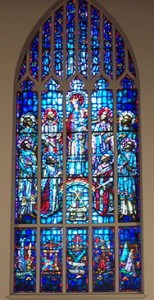
The stained-glass window over the main altar was donated by the Doran family, and was designed and made by Theo Lubbers, a Dutch artist living in Montreal. He also designed the side windows depicting the Way of the Cross.
Canadian Martyrs was Father Herlihy’s first parish and he was the key priest in the development of the parish in its young, vibrant years.
Following Father Herlihy’s term, Father Gerald Cousineau OMI was appointed pastor on July 1, 1959. An Ottawa native, he also grew up in St. Joseph’s Parish and graduated from the University of Ottawa. Although he served for only three years, Father Cousineau took on the responsibility of building a new rectory for the parish. During his long association with Canadian Martyrs Parish, Father Cousineau won the hearts of the parishioners, and in March 1980, a farewell party was given in his honour, at which time the parish wished him a happy, healthy, well-earned retirement.
Father Donald Brennan OMI, who was an assistant to Father Cousineau, was appointed pastor in 1962 and remained in the office until November 1968. Father Brennan graduated from St. Patrick’s College after having received his early education in Maniwaki, where he was born. He was very popular with the young people of the parish and dedicated much time to their welfare. Regular weekly meetings were held for both senior and junior members of the Catholic Youth Organization (CYO). He also organized hockey teams among the altar boys. It was during Father Brennan’s term of office that the many changes, resulting from Vatican II, were to take place, a heavy responsibility for a young priest serving his first pastorate. His hobby was growing flowers which was very apparent from the beautiful arrangements of shrubs, roses and annuals decorating the church grounds.
Father Kevin McNamara OMI succeeded Father Brennan. He was appointed pastor on November 18, 1968, after serving for a year as assistant to Father Brennan. A former federal public servant who chose a religious life, Father McNamara brought with him a vast knowledge and experience in the field of finance. Before coming to Canadian Martyrs, he served for several years as bursar of St. Patrick’s College. A native of Eganville, Ontario, a community which has given a great number of its sons and daughters to the Church, his background of small-town friendliness was to make for an easy adjustment to parish work. He served until August 15, 1974, during which time much of his responsibility was the continuing adjustments of the many changes resulting from Vatican II. He also directed the formation of the first Parish Council.
On August 5, 1974, Father Archie Daley OMI was appointed pastor. Another son of St. Joseph’s parish, Father Daley graduated from St. Patrick’s College High School and continued his religious education at Holy Rosary Scholasticate, later going to Rome to study philosophy and theology. Upon his return, he had many pastoral assignments throughout Canada and for a number of years he was Director of Retreats at Villa Madonna Retreat House in Ottawa. A most charitable man, he took special interest in the sick and the needy. He left the parish on August 15, 1979 to serve as pastor of St. Bernard’s Church, Enfield, Nova Scotia.
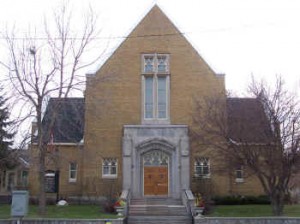
At the conclusion of Father Daley’s term, Father John Kroetch OMI was appointed pastor. One of 11 children, Father Kroetch was born in the small farming community of Strome, Alberta. He received his early education in Alberta and later studied at the Oblate Novitiate at Arnprior and at Holy Rosary Scholasticate at Orleans. He was ordained on June 26, 1965 in his home parish of St. Agnes in Edmonton. Father Kroetch guided the 50th Anniversary celebrations at Canadian Martyrs.
After the reassignment of Father Kroetch in 1980, Canadian Martyrs parish had a succession of “caretaker” pastors under an Oblate Administrator, each of whom directed his energies to the maintenance of parish life. This period, however, also saw changes in the parish community – fewer young people, families moving to the suburbs and the older parishioners moving to nursing homes. At the same time, there was an acute shortage of priests due to the heavy demand made upon the Oblates in their vast mission fields in our north country as well as in South America.
Father Pat Larond came for a short time, but his craggy face and gentle eyes kept looking to the North rather than to his country of birth, France. His wish was granted and he returned to the Northern Missions.
In 1982, Father Harold Conway OMI was appointed Pastor of Canadian Martyrs. Father Conway was well known to the parishioners. Throughout his career, Father Conway was active in Teacher’s Associations, at national and international levels, and was a founder of the Canadian College of Teachers and a member of the founding Board of Governors of the Ontario Institute of Studies in Education, University of Toronto. In 1981, he received the Order of Canada. When Father Conway suffered a stroke, Father Fred Miller took his place as Parish Priest.
I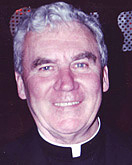 n 1987 Canadian Martyrs Parish welcomed the appointment of Father Laurie Conlon OMI. Father Lawrence Joseph Conlon was born in Ottawa East to John and Ethel Conlon and was baptized in Holy Family Church. He attended Canadian Martyrs School, St. Patrick’s College High School and St. Patrick’s College.
n 1987 Canadian Martyrs Parish welcomed the appointment of Father Laurie Conlon OMI. Father Lawrence Joseph Conlon was born in Ottawa East to John and Ethel Conlon and was baptized in Holy Family Church. He attended Canadian Martyrs School, St. Patrick’s College High School and St. Patrick’s College.
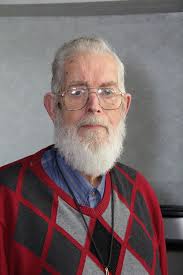 Father Carl Kelly, OMI, served Canadian Martyrs parish from 1998 to 2006.
Father Carl Kelly, OMI, served Canadian Martyrs parish from 1998 to 2006.
Many will remember Fr. Carl for the years he spent at St. Pat’s High School, as a teacher, vice principal and principal until 1973. Then as a missionary, Fr. Carl was sent to Dhaka, Bangladesh, returning to Ottawa following an accident there in March 1974. Fr. Carl continued his teaching ministry in Richmond Hill at St. Robert’s High School and then moved back to Ottawa to take up the position of Director of Chaplaincy at the University of Ottawa, a position he held until July 1981. Over the next 36 years, Fr. Carl thrived in pastoral ministry, working in parishes in Hamilton, Thunder Bay, Springhill (NS), Toronto, Shubenacadie (NS) and finally, Canadian Martyrs Parish.
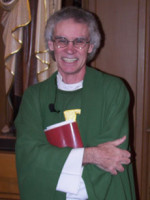
Father Robert Smith, OMI, served Canadian Martyrs Parish from 2006 to June 2013. During his tenure as pastor, one of Father Robert’s key areas of focus was assisting the parish in developing and implementing our Pastoral Plan.

Father Nicanor Sarmiento, OMI, served Canadian Martyrs from August 2013 – 2015. Nicanor was born in the Quechuan community of Lares, in Cuzco, Peru. From his youth as a shepherd in the far Andes, he moved on to become a Catholic priest of the Oblates of Mary Immaculate (OMI) with a doctorate in Theology and Cultural Anthropology. Along the way he spent six years as a missionary in the Innu communities of Sheshatshiu and Natuashish on the far northern coast of Labrador, thousands of kilometres away from the flocks he used to tend.
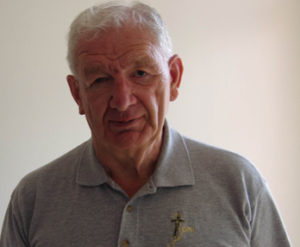
Fr. Jim Fiori, OMI served Canadian Martyrs from 2015 – 2017. Fr. Jim enjoyed making Canadian Martyrs his home, both physically and spiritually. If there’s one thing he learned in his travels, he says, it’s that a home is more than the physical place where he lives. “My first responsibility is that I want to become holy,” he said. “I want to journey with the people. You can’t lead where you have never been.”

Fr. Timothy Coonen, OMI became pastor at Canadian Martyrs in January 2018. He writes: “I remember the vibrancy and energy that Father Robert Smith brought to every celebration during his tenure. Father Nicanor Sarmiento Tupayupanqui brought his brilliant intellect to the table, but became especially engaging when his notes fell to his side and he spoke from the heart about his aboriginal roots in his native Peru. And Father Jim Fiori, with his deeply personal reflections and stories, brought the scriptures to life in his own unique manner.
In a manner of speaking I feel like I’m standing on the shoulders of giants (well, Robert and Nicanor are hardly ‘giants,’ but you know what I mean!). I’m grateful to them, and also to all of you who have welcomed me here; I look forward to our journey together….”. Fr. Tim retired in the summer of 2025 and we welcomed Fr. Frank Kuczera as our new pastor.
